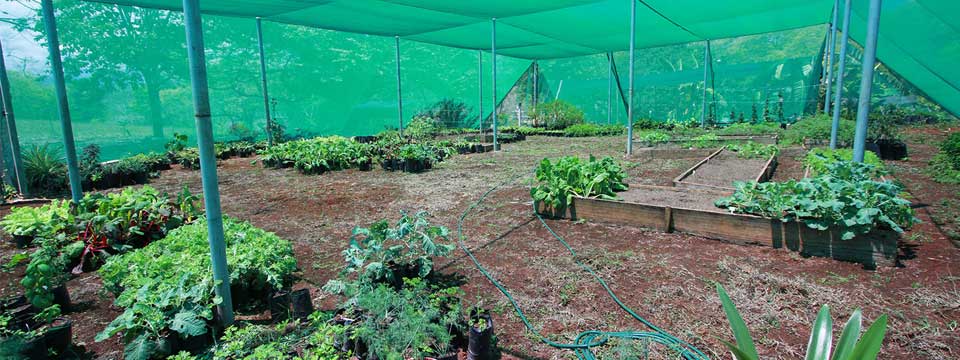Shade Structure for Growing Vegetables
Updated March 6, 2015
This project we consider to be a big failure!!! It works great in dry season, but the problem was that in the rainy season, the mesh lets in all the rain, but not enough light or sun. This led to extremely humid conditions that most plants could not tolerate. Fungus grew on almost everything. Plus, bugs got in anyway, and multiplied without any predators to keep them under control. We opened the sides and that helped, but still too much humidity and fungus.
So, we removed all mesh and rebuilt the structure as a split-roof greenhouse, covering the top with translucent plastic. The sides are left open. This allows us to control the amount of water for the plants, the translucency limits the direct sunlight, and we can suspend mesh over some very heat-sensitive plants. This is working MUCH better!
Updated May 2, 2013
I think we were the first (and still the only) people to build a large shade structure for growing vegetables. I had been imagining the idea for many years, since my very first visit to Costa Rica, when I went to the Tierra de los Milagros yoga resort in the Osa Peninsula, and saw their small salad-growing structure, which had a simple plastic mesh roof. They told me the mesh served to purposes: to protect the veggies from too much sun and too much rain. They had most of their veggies up on tables and that seemed very expensive, but they did that to help keep critters off them.
So I wanted a BIG tent which would protect our plants from the rain and sun, while keeping out iguanas, lizards, bugs, and other things that like to dig up gardens. At Anamaya we had already experienced Coatis digging through our bagged and potted plants, destroying dozens in a night while looking for grubs in the soil.
The solution was to build our current structure, which is supported by galvanized steel posts and steel cables. We have two types of mesh:
80% shade on top: for blocking out the intense tropical sun
70% shade on sides: for allowing more airflow through (we need to keep it from getting too hot)
The poles serve a secondary purpose in that they also are used to support vines by stringing galvanized wire between them.
So far, we’ve had mixed success with it.
On the positive side:
–It’s great for growing seedlings, to protect them from heavy rain (rain disperses into smaller drops as it hits the roof and comes down more as a mist).
–Some plants seem to like the 80% shade, such as some types of herbs.
–We haven’t had any problems on heavy wind days as far as the plants getting battered or knocked over.
–Not one attack inside from iguanas or deer (but have had problems outside).
Negatives:
–Predators can’t get into the structure to eat bugs, and we’ve had some problems with “white-flies” attacking our kale, and caterpillars attacking the arugula and Tat Soi. We are trying to do a better job of keeping bugs out to help with this.
–Many plants are doing better outside in full sun, now that we’re generating great soil.
–The shade structure can get very hot when there’s full sun and not much wind.
–Fungus! When it rains for several days in a row, fungus grows on top of the soil, both on the ground and in the bags. This doesn’t happen outside of the shade structure, so it seems there’s not enough light getting in, and a lot of humidity.
Solutions:
We’re considering three options:
1. Leave it as is and just move seedlings outside once they’re large enough to handle rainstorms, and mix the plants up better for more biodiversity, rather than keeping “like kind” plant bags together.
2. Make a double “air-lock” set of doors and buy some non-native songbirds to keep permanently inside like an aviary, to see if they’ll eat the bugs. But, we already found that our lazy picky chickens won’t eat the marauding caterpillars, so we’re not sure if this will help anything. But it would be cool to have the birds anyway.
3. Fold open up the sides more fully so birds can easily fly in all day, closing it all up at night to keep out larger pests.
4. Ladybugs! We need ladybugs, but I’ve never heard of anyone using them in Costa Rica.
Crazier Solutions:
5. More Spiders! I have personally (Geoff) captured at least a dozen tarantulas and let them loose in here, hoping that they’ll stick around and eat pests. But we never see them again so they seem to be escaping. We could perhaps build habitats for them such as rock piles so they’ll hang around, or find other spiders. More about our conscripted Tarantula army here: Tarantulas
6. Wasps! There are many types of predatory wasps that live in the jungle. Howe can we encourage them to live here and eat our bugs? Solved! Read about how to do it here: Predatory Wasps for Organic Farm Pest Control
















